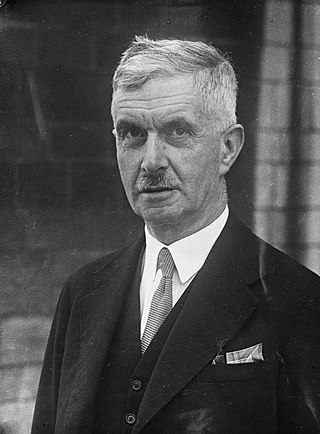
The 1824 United States presidential election was the tenth quadrennial presidential election. It was held from Tuesday, October 26 to Thursday, December 2, 1824. Andrew Jackson, John Quincy Adams, Henry Clay and William Crawford were the primary contenders for the presidency. The result of the election was inconclusive, as no candidate won a majority of the electoral vote. In the election for vice president, John C. Calhoun was elected with a comfortable majority of the vote. Because none of the candidates for president garnered an electoral vote majority, the U.S. House of Representatives, under the provisions of the Twelfth Amendment, held a contingent election. On February 9, 1825, the House voted to elect John Quincy Adams as president, ultimately giving the election to him.

The 1968 United States presidential election was the 46th quadrennial presidential election, held on Tuesday, November 5, 1968. The Republican nominee, former vice president Richard Nixon, defeated both the Democratic nominee, incumbent vice president Hubert Humphrey, and the American Independent Party nominee, former Alabama governor George Wallace.

Ella Jane Fitzgerald was an American singer, songwriter and composer, sometimes referred to as the "First Lady of Song", "Queen of Jazz", and "Lady Ella". She was noted for her purity of tone, impeccable diction, phrasing, timing, intonation, absolute pitch, and a "horn-like" improvisational ability, particularly in her scat singing.

John Birks "Dizzy" Gillespie was an American jazz trumpeter, bandleader, composer, educator and singer. He was a trumpet virtuoso and improviser, building on the virtuosic style of Roy Eldridge but adding layers of harmonic and rhythmic complexity previously unheard in jazz. His combination of musicianship, showmanship, and wit made him a leading popularizer of the new music called bebop. His beret and horn-rimmed spectacles, scat singing, bent horn, pouched cheeks, and light-hearted personality have made him an enduring icon.

Mary Lou Williams was an American jazz pianist, arranger, and composer. She wrote hundreds of compositions and arrangements and recorded more than one hundred records. Williams wrote and arranged for Duke Ellington and Benny Goodman, and she was friend, mentor, and teacher to Thelonious Monk, Charlie Parker, Miles Davis, Tadd Dameron, Bud Powell, and Dizzy Gillespie.

Eli "Lucky" Thompson was an American jazz tenor and soprano saxophonist whose playing combined elements of swing and bebop. Although John Coltrane usually receives the most credit for bringing the soprano saxophone out of obsolescence in the early 1960s, Thompson embraced the instrument earlier than Coltrane.

The 1892 Republican National Convention was held at the Industrial Exposition Building, Minneapolis, Minnesota, from June 7 to June 10, 1892. The party nominated President Benjamin Harrison for re-election on the first ballot and Whitelaw Reid of New York for vice president.

James Chuter Chuter-Ede, Baron Chuter-Ede,, was a British teacher, trade unionist and Labour Party politician. He was a Member of Parliament (MP) for 32 years, and served as the sole Home Secretary under Prime Minister Clement Attlee from 1945 to 1951, becoming the longest-serving Home Secretary of the 20th century.
Thomas J. Harens is a former third-party candidate for President of the United States in the 2004 presidential election in which he was only on the ballot in Minnesota. His running mate was Jennifer A. Ryan. He had created the Christian Freedom Party in June 2004, and filed his "affidavit of candidacy" with the Minnesota Secretary of State in August.

"Caravan" is an American jazz standard that was composed by Juan Tizol and Duke Ellington and first performed by Ellington in 1936. Irving Mills wrote lyrics, but they are rarely sung.
William Melvin Mitchell was an American jazz tenor saxophonist.

Oscar Peterson and Dizzy Gillespie is an album by Oscar Peterson and Dizzy Gillespie that was released in 1974. At the Grammy Awards of 1976, Gillespie won the Grammy Award for Best Jazz Performance by a Soloist for his performance on this album.

A Tribute to My Friends is a 1983 album by Oscar Peterson.

An Electrifying Evening with the Dizzy Gillespie Quintet is a 1961 live album by trumpeter Dizzy Gillespie, recorded at the Museum of Modern Art in New York City.

Diz and Getz is an album by Dizzy Gillespie, featuring Stan Getz.

Dizzy Gillespie's Big 4 is an album by Dizzy Gillespie recorded in 1974 and released on the Pablo label.

Soul Junction is an album by the jazz pianist and composer Red Garland. It was released in 1960 through Prestige Records. It features tracks recorded on November 15, 1957, the same day the pieces for All Mornin' Long were recorded, with the same lineup.
"Birks' Works" is a 1951 jazz standard written by Dizzy Gillespie. The title refers to Gillespie's middle name, "Birks". It was the title track of Gillespie's 1957 album Birks' Works.

The presidential transition of Jimmy Carter began when he won the 1976 United States presidential election, becoming the president-elect, and ended when Carter was inaugurated on January 20, 1977. Carter had become president-elect once the election results became clear on November 3, 1976, the day after the election.

















